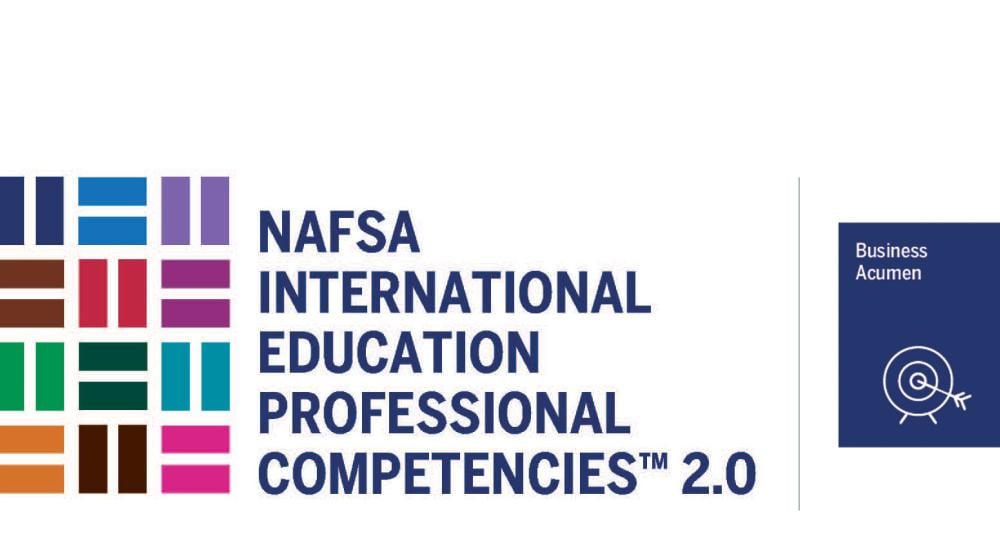Clay Harmon: Financial Acumen As a Tool to Effect Change

With deep experience on campus as an international enrollment and admissions professional and a new position as CEO at AIRC: the Association for International Enrollment Management, Clay Harmon has approached budgeting in international education from a variety of perspectives.
Harmon spoke with International Educator about why business acumen and financial fluency are essential for all international educators; how to use intercultural communication skills to build relationships with the finance office; why the business side of international education isn’t at odds with the mission-driven nature of the work; misconceptions and assumptions about budgets on campus; how to weigh competing priorities; and why playing the financially responsible long game can yield big results for international programs.
Editor's note: This interview has been edited for clarity and length.
You have a background of working on a campus and are now serving as CEO at AIRC. Given your range of experience, what has been your career journey regarding financial acumen and understanding the business side of the field of international education?
My journey in this area really took place in the context of public institutions—community colleges, public research universities—where it seemed like there was never enough money to support everything the institution wanted to accomplish. In a resource-scarce environment where you have to fight for every dollar and you risk budget cuts every year, it becomes critically important to demonstrate the value of every dollar spent and the return on the investment (ROI) that you’re making on the institution’s behalf.
Another helpful perspective I gained from working in international student recruitment and admissions—and one that I actually wish more institutional leaders would pay attention to—is the student’s perspective on finances. The vast majority of international students are highly focused on the return of their own investment. In other words, they want to be confident that in coming to the United States, studying at your institution, and spending the tens of thousands of dollars we’re asking of them, they will see results in terms of strong employment prospects and a better life for themselves and their families. It’s beneficial for institutions to be prepared to converse at that same level with [students]. I think our students are actually the best teachers when it comes to making strategic, thoughtful choices about money.
What are the different factors or variables for institutions when it comes to their budget strategies? Does institutional type—for example, a community college versus a four-year university—matter?
I’m not sure that institutional type is necessarily a huge deciding factor so much as other kinds of contexts. For instance, public versus private might have more of an impact; whether there is a big research enterprise at the institution or not; how much of an endowment the institution has and how restricted that endowment is; how effective or ineffective the advancement or development office is. There are community colleges out there that have very active foundation arms that are better able to support some international activities through fundraising. There are probably trends and generalities that can be identified, but in my experience, every institution is a special snowflake, and they all have their own very specific contexts. I’m wary of drawing too many broad generalizations.
Given that no two institutions are going to have the exact same set of variables and there is no one-size-fits-all approach to budgets, why is business acumen an important skill for everyone working in international education—whether you’re a senior international officer at a big R1 university or a study abroad adviser at a community college? Why is it essential for all these people to understand basic financial principles?
There are two primary reasons that I see. First and foremost, fluency with budgets and finances helps us understand what we can and cannot do. An office with a clearly delineated line-item budget is better positioned to know whether they can travel to a certain country or run a certain study abroad program or purchase online advertising. [They know] how they can shift funds if necessary, if priorities change in the middle of the fiscal year. When an office is not equipped with this knowledge, I’ve seen them hold off and avoid spending money, which means that you’re not maximizing your impact. And it also means that any unspent money might get swept at the end of the year. Or, conversely, they overspend and they get in trouble that way. It’s always better, in my view, to optimize your funding. And to do that, you have to be able to create and read a budget.
Financial analysis helps you tell the story of your own effectiveness.
The second reason is that financial analysis helps you tell the story of your own effectiveness. This goes back to that ROI idea that I mentioned. In the international admissions context, I always strove to track the cost of student recruitment activities as well as their positive impact in terms of enrollment—in other words, the return on the investment that the institution was making for those recruitment activities—which is a challenging thing to do. And there were lots of caveats and there’s a certain lack of clarity that you can’t get past. But still, when we had the ROI laid out, we could demonstrate the value of continuing or increasing funding for certain activities.
We could also easily see which activities were not generating a return and thus could be modified or eliminated. For example, at one of my institutions we determined that travel to Brazil was turning out to be really expensive, and we could not identify any enrollments that had come from it. Conversely, [our] travel to Nepal generated an enormous number of applications. And so, by tracking that, we were able to shift resources and be more effective.
What are some ways international educators can shift their thinking to realize the importance of fluency in these areas?
One common misconception that folks have about budgeting and finance is that they require high-level math skills, and I think that turns a lot of people off. It’s not really the case. If you can build in a way to feel empowered and not be overwhelmed by it, you start recognizing that common sense is more applicable to budgets and finances than folks think of at first.
The other way that I think is really critical in terms of shifting perceptions is that leaders can sometimes be cagey about their budgets and prefer to keep information to themselves. There are sometimes good reasons to be cautious, but I generally lean toward sharing as much information as possible with my staff, because I can get their valuable input on ways to spend the resources. I can also help them understand the challenges that we face. Simply talking through the budget and working from the same basis of information can help folks become more comfortable with budgeting and understand how money connects to the office’s activities. Plus, it’s great professional development.
It seems like some people working in the field feel an aversion to talking about the financial and business aspects of international education—that it feels at odds with the deep sense of mission and purpose they have about their work. How can we move past this myth that these things are at odds with each other?
I agree that money is not a motivator for most of our colleagues in international education, and I don’t think it should be, necessarily. The big ideas that inspire us to do this work are much more fulfilling and valuable in many ways than the bottom line. I think that’s as it should be, but international education does not exist in a vacuum. We as international educators must understand and navigate the larger world in which we operate.
International education does not exist in a vacuum. We as international educators must understand and navigate the larger world in which we operate.
This often means engaging in advocacy, whether advocating within the institution for additional funding and staffing, joining NAFSA’s Advocacy Day, or otherwise advocating to government bodies for legislative or regulatory changes. Many of these decision-makers are much more connected to and tend to care about money more than international educators do, which means that, in order to be effective in advocating, we have to speak their language.
Tools like NAFSA’s infographics showing the economic impact of international enrollment by state and by congressional district can be very helpful in this regard. On a smaller scale, projections of international tuition revenue can help persuade institutional leaders. If we can retain our internal motivations that make us get out of bed every day, we’re trying to make the world a better place through everything we do. And if we’re fluent in the impact that the money can have, then we can be more effective in advocating for ourselves.
Building on that idea that many international educators are driven by their mission and values—do you think that the way that an international office spends its money and allocates its resources can reflect its values?
As a general principle, I do believe that. At some level, every budget, no matter the circumstance, is always a reflection of the organization’s values, because every budget is composed of choices.
But it’s also not fair necessarily to judge an international office’s budget on the surface. Many international offices face myriad pressures from many, many different directions when crafting their budgets and spending their funding. There could be external mandates, institutional rules, or simply conflicting priorities. There’s so much to do, and there’s only a limited amount of money to do it with. Sometimes the amount of funding that an international office is functionally able to allocate to certain causes does not always align with how much they value those causes.
What stands to be gained when international educators can shift to a mindset that considers money—and the understanding of how all of this works together—as a tool to effect change and empower students and staff?
It’s all about the positive framing. There’s a concept in leadership about framing and how the way that a question or issue is posed can influence the way that people think about it. If we begin with a positive framing of, “This is a tool that we can use,” then that’s a really good starting point. If we have a stronger understanding of money and we can track, again, the ROI of our activities, it’s easier to see and appreciate the impact of our individual work and our collective work. That can be really refreshing and inspiring, to look back and say, “I was able to take a small pool of money and turn it into an impactful event for our international students. And we had positive event feedback surveys and students telling us that they were able to make friends and they feel more connected to their community. I was able to do that with only this amount of money. What can I do next?” It leads to a positive spiral of thinking.
Do you have a story or an experience where you learned a lot about the power of these skills? Either a success story or a learning moment?
The example that really stands out to me is from when I had a supervisor at a previous institution who was very clear and had very high expectations for all of us in terms of budgeting and financial acumen. [We were expected to be] very careful stewards of institutional money and recording everything, which at first felt burdensome or awkward; it required a learning curve to get there. But, eventually, I came to understand that there is a political value to it as well. Because over the course of many years, our international office gained a positive reputation on campus, particularly with the finance team, of being good stewards, of being one of the few units on campus that could answer questions of, “How much money do you have left in your budget? What has been the impact of spending your budget?”
If we have a stronger understanding of money and we can track, again, the ROI of our activities, it’s easier to see and appreciate the impact of our individual work and our collective work.
We were better prepared than many other units to make the case for additional funding because of that. As a direct result of many years of building a positive reputation, I was successful in convincing the finance office to include international students in a scholarship program. If we had not done that long, patient work of really engaging with our budgets over many years, we would not have been prepared to make that case.
Speaking of being able to successfully make a request, most international educators have strong intercultural skills, including intercultural communication skills. How can they use those skills to build relationships with the finance office, whose members sometimes seem like they are speaking another language?
That’s an interesting question that’s really nicely framed, because professional cultures definitely exist in different fields and, in many cases, can be just as relevant and important as ethnic or regional or international cultures. I do think intercultural communication is a very helpful and appropriate way to think about the issue. Plus, framing it this way leans into our skills and strengths as international educators, and it is usually more effective to lead from a place of strength, right? If you can reframe what might feel like an unequal conversation with the finance office and [think about] it instead as, “I’m going to start this from a place of intercultural communication,” then you’re starting from your strength.
Framing it this way leans into our skills and strengths as international educators, and it is usually more effective to lead from a place of strength.
In concrete practice, in addition to what I was saying about building up trust over the long term, another great way to do it is to focus on the goals that we all do have in common. Everyone is interested in the institution’s long-term sustainability and the success of its mission. That’s the whole point, right? The finance office is interested in those things just as much as the international office is, even if we’re coming at them from radically different perspectives. If we can establish the baseline that we are all on the same team and we are all aiming for the same objectives, then it’s easier talk about how to triangulate from our different perspectives and positions on how to get there.
That sounds like an exercise for both groups in challenging the assumptions that they have of the other group, which is always interesting. What are some common assumptions or misconceptions about budget or finances on campus, whether specifically with the international office or more widely?
There are so many [assumptions] from so many different perspectives, so here are just a few. I think both international students and institutions tend to have overly inflated impressions of how much money the other party has. Many prospective international students or applicants assume that U.S. institutions must have abundant resources simply by being in the United States, and therefore, there must be scholarships or other forms of financial aid available [if you keep asking]. That’s simply not true for most of our institutions.
Meanwhile, staff and faculty often assume that international students are all independently extremely wealthy or they have access to government sponsorship. Therefore, financial issues are not a problem, and we can continually raise tuition, and students will be fine. Honestly, I think the I-20 funding requirement is a strong contributor to this misconception. There isn’t really a way around that; the reality is that the government has a compelling interest in ensuring that international students are solvent and that they’re not going to become a burden on the state when they come. But the impression that it often generates is that if you have [a certain amount of money] in the bank that you can demonstrate to get your I-20, you must have access to a lot of wealth.
That’s really not the case for a lot of students. The struggles that our students faced during the COVID-19 pandemic when they lost their on-campus jobs, for example, revealed just how precarious many international students’ financial situations actually are.
Those are two really thorny and long-term misconceptions, but then there are other ones. From an intrainstitutional point of view, I think international offices are sometimes accused of administrative bloat—of wanting to hire too many staff to do the work. The caseloads for ISSS (international student and scholar services) and study abroad staff, for example, might be lower than caseloads for academic advisers, and that can be seen as an inequity. We need to challenge that, because there are some highly specific skills needed in our field to handle very complex and ever-changing requirements. Things like international credential evaluation are very, very complex. Immigration compliance gets progressively more burdensome from year to year and more complicated, especially depending on how the winds are blowing in Washington, D.C. So, there are genuine reasons why it might make sense for an international office staffer to have a lower caseload than an academic adviser, depending on the circumstances.
When you start realizing the financial impact that a single international student can have, that conversation can change pretty quickly.
Another misconception might be that international priorities are nice-to-haves instead of must-haves, therefore they’re always something that could be cut. But again, talking about financial acumen at a public institution, when you start realizing the financial impact that a single international student can have, that conversation can change pretty quickly. It’s hard, especially when you’re in a complex organization with limited resources and there’s a lot of competition for priorities. But the fact is that I don’t know of any international office that is actually overstaffed.
I don’t think anyone reading this interview would volunteer to say that their office is overstaffed! Earlier, you mentioned that it’s helpful if international offices can start from the same place with other units on campus as far as having the same basic goals. What advice do you have for international offices to help them better understand their institution’s big-picture budget and how to work within that context?
I advise everyone—everyone who works at an institution, whether you’re faculty or staff, no matter what office you work in—to spend some time to do the homework and really dig in and understand the institution’s primary revenue sources and primary sources of expenditure. Everyone who works at an institution needs to be familiar and conversant with the differences between general funds, auxiliary funds, and restricted funds. Often, there are documents outlining this on the finance office’s website; sometimes, you can find an annual budget presentation to the board of trustees. Frankly, I think good CFOs (chief financial officers) should be presenting to their campuses at least once a year about finances, particularly during tough years. That’s extremely valuable PR for them to do that kind of outreach and help everyone understand.
Everyone who works at an institution needs to be familiar and conversant with the differences between general funds, auxiliary funds, and restricted funds.
But it’s also incumbent upon all of us to do the homework and to understand that. Doing that homework can really help international educators understand the institution’s priorities and its limitations. For example, especially with our Ivy League friends, you see these eye-popping headlines about the overall value of their endowments. But if you actually dig in, you realize that endowment, that headline number, is made up of hundreds or thousands of different funds, each of which has a small amount in it and is dedicated to a very specific purpose. Just because the institution as a whole may have a large top-line number for their budget, that doesn’t mean they actually have the freedom to use those funds and move them around. I think it’s really valuable for everyone who works in an institution to understand that, because, without it, you can jump to conclusions, you can build resentments based on assumptions—"Why does this office get something that we can’t afford?” And there may be a specific funding line or specific donor. You never know. I think it’s really critical that everyone educate themselves.
We’ve talked a lot about staff who work in international offices. While, in terms of the day-to-day, they are more likely to speak the same language as their third-party providers than they are with finance offices, there are significant differences between institutions and providers. What should providers know about budget realities and financial decisions at institutions and vice versa?
The biggest difference is the for-profit versus nonprofit mindset and divide. Higher education is a special industry that has very unusual economics and unusual approaches to finances. If I am a provider, like a for-profit study abroad organization or an international student recruitment agency, I’m a for-profit business. I understand the concept of investment, of taking risk, that it takes multiple years to build market presence and all of these kinds of things.
As an international admissions or a study abroad employee, I might also understand those concepts, but the way that institutional budgets are constructed often does not support that [understanding]. It might seem like an obvious thing to say, “Well, if we invest in some scholarship dollars, we can recruit more students, which will generate more tuition, which will have a positive impact and eventually pay for itself.” But institutions often tend to be more conservative, and they tend to see that scholarship that you’re proposing as a cost rather than investment. That can be really challenging for an external provider from the outside looking in to say, “This is such a no-brainer.” But that’s not where institutions are coming from.
They can understand each other’s realities, but they’re not living in those realities.
It can be really frustrating. My primary background is in international recruitment and admissions, which does require an outlay and an investment of resources in terms of marketing, in terms of travel, in terms of agent commissions, or whatever it is. It also generates revenue through tuition and fees from the eventual enrollment of students. But it always appears in the budget that the international admissions office has this outsized budget that’s larger than ISSS or larger than study abroad or other places and that there’s some kind of inequity or problem with that, when the reality is you have to be investing. Bringing folks around to that kind of thinking at the institution can sometimes be really hard.
It seems like coming out of the pandemic, most people are dealing with decreased revenue and increased expenses. In that environment, how do you balance competing financial priorities?
This is the question with a capital Q! This is something that all of us face every day, and it doesn’t get easier over time. As we face issues like the demographic cliff coming up […] like the rise in mental health needs for students, costs increase and potential revenues decrease. So many institutions are really feeling the crunch, and there’s no easy answer. There’s certainly no universally applicable, one-size-fits-all answer, because as we discussed earlier, every institution is unique and their circumstances are different.
But there are a few things that can help. In my view, it’s helpful to have a very clearly articulated strategic plan or list of strategic objectives, because this provides an automatic benchmark for every decision. Does spending this money or taking advantage of this opportunity advance one of our identified strategic objectives? Or could we advance our strategic objectives more effectively by spending the money in a different way? That is a baseline, fundamental test that you can start applying but only if you have those objectives clearly identified.
In my view, it’s helpful to have a very clearly articulated strategic plan or list of strategic objectives, because this provides an automatic benchmark for every decision.
The other is back to what I mentioned earlier on—having a clearly articulated line-item budget with your subpriorities identified. That is helpful in terms of identifying where you can move funding around. If a particular trip didn’t happen because somebody went on parental leave, we’ve got some money left over; great, now we can apply it to this other priority. But if we hadn’t laid it out like that, we might not have been as clear about where those pockets exist.
Can you talk a bit about how investing in your staff’s professional development in this and other areas can not only benefit them as individuals but also the office in general and its effectiveness on campus?
International education, no matter which knowledge community you’re a member of, is an incredibly dynamic, constantly changing field. There is a very compelling need for professional development. On the ISSS side, again, with constantly changing visa requirements, it’s critical that ISSS folks have continual access to professional development, even very experienced folks. As the markets for international student recruitment continually shift and as different things happen with geopolitics and the global economy, international admissions and recruitment staff need to be aware of the trends so that they can be more effective in making decisions. We could come up with examples for study abroad, for internationalization of the curriculum, for partnerships, for transnational education, and for all the different areas. If you’re going to remain relevant, much less effective, you have to stay abreast of what’s happening. •
NAFSA Resources
About International Educator
International Educator is NAFSA’s flagship publication and has been published continually since 1990. As a record of the association and the field of international education, IE includes articles on a variety of topics, trends, and issues facing NAFSA members and their work.
From in-depth features to interviews with thought leaders and columns tailored to NAFSA’s knowledge communities, IE provides must-read context and analysis to those working around the globe to advance international education and exchange.
About NAFSA
NAFSA: Association of International Educators is the world's largest nonprofit association dedicated to international education and exchange. NAFSA serves the needs of more than 10,000 members and international educators worldwide at more than 3,500 institutions, in over 150 countries.
NAFSA membership provides you with unmatched access to best-in-class programs, critical updates, and resources to professionalize your practice. Members gain unrivaled opportunities to partner with experienced international education leaders.















